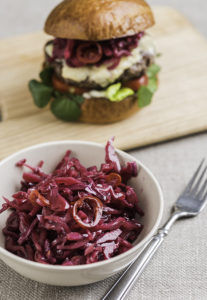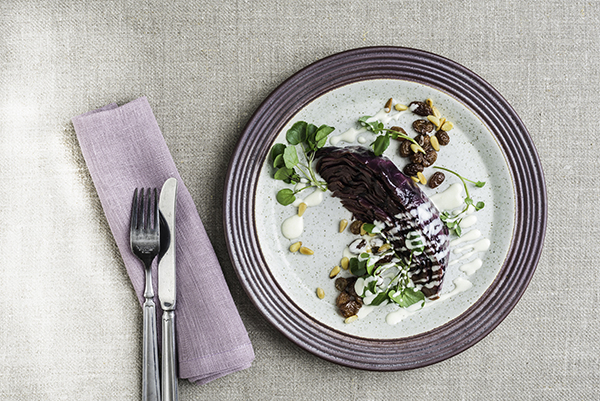Home-grown harvest: Red cabbage
We all love it slow-braised with a roast or chopped up in a slaw, but as well as the classics, there are dozens of unusual ways to serve red cabbage. Russell Brown explores
The rich purple hue, the sticky softness and the intense sweet and sour flavour of braised red cabbage are synonymous with autumn and winter menus. It is the time of year when comfort food comes to the fore and red cabbage fits well with this brief. Is it just about slow braising, though, or is there more to red cabbage than meets the eye? Like all of the brassicas, red cabbage can be used in myriad different ways, with the option of using it raw being a significant one.
Red cabbages are available all year round but the main season is from September to December. Typically, the leaves are a deep red/purple colour, but this is determined by the pH of the soil the plants are grown in: on acidic soils the leaves are that deep red, while on more alkaline soils they can change to a yellowish green. The pH level affects the colour of the cooked vegetable too; simply boiled, the leaves will turn blue, so a little vinegar is used to retain the colour.
It is a vegetable that stores very well, hence the year-round availability. One of the major UK growers is Naylor's in Lincolnshire, which was established by William Naylor in the early 1900s. It is now fourth-generation grower with Simon Naylor in charge.
Cooking methods and usage for red cabbage are varied, but numerous versions of braised red cabbage top the charts. The common components tend to be onion, fruit, vinegar and sugar. Red onion, apple, sultanas and spices are all frequently used, too. My own recipe is probably one I picked up early in my career and contains brown sugar, red wine vinegar, white wine vinegar, port and balsamic vinegar.
The cabbage is often used raw, too, either pickled, in various slaws or dressed salads. A variation on braised red cabbage is using it to make a punchy ketchup. The flavourings tend to be simpler and the cabbage is cooked down until it is completely tender before being puréed. Xanthan gum or Ultratex are sometimes used to bind the sauce.
I asked my usual question on social media as to how chefs like to use red cabbage and it drew one of the more extensive and diverse set of answers. Damian Wawrzyniak, chef-consultant and owner of House of Feasts in Peterborough, serves fermented red cabbage with pierogi and a black ash tuile de pain, while Marc Wilkinson at restaurant FraÁ®che in the Wirral makes a red cabbage granita to serve with a blue cheese foam and linseed. Cambridge-based chef Mark Poynton recalls a dish when he worked at the Juniper restaurant in Cheshire that required the cabbage to be cut into a brunoise, sautéed and then left to hang in muslin for a day for the juices to run out. The seasoned juices were then used in the sauce.
Gordon Craig, head chef/owner of Taisteal in Edinburgh, uses red cabbage with grilled venison, Parisian gnocchi, pumpkin, wild mushrooms and sesame seeds. He cuts the cabbage into 1cm slices, cooks on a high heat to caramelise the natural sugars then adds red wine and port and cooks down until tender. To finish, he adds quartered red grapes and juniper salt. And in Devon, at restaurant Pattard Kitchen, chef BjÁ¸rn Moen uses braised red cabbage to make a purée served with five-spice mushrooms, duck breast and fondant potato.
Buying and storage tips
•Red cabbages should feel solid and heavy for their size
•Store cabbages whole, as once cut they will deteriorate more quickly
•Store in the refrigerator
•Wrap cabbage in clingfilm to retain moisture
Market report
The price at the moment for red cabbage is about 45p-50p per kilo. A month ago you couldn't find red cabbage for less than 65-70p, so the price is improving.
It's rare to find quality issues when using red cabbage, so it's a safe vegetable with which to work.
English red cabbage is available for a large part of the year, but if there are gaps in supply, Dutch red cabbage is a great alternative.
Ashley Clemencewww.totalproducelocal.co.uk
Chilli-pickled red cabbage
100g caster sugar
100ml red wine vinegar
4 juniper berries, crushed
4 black peppercorns
1½tsp Maldon sea salt
1tbs olive oil
1 clove of garlic, minced
200g red cabbage, finely shredded
1 red chilli, finely sliced
To make the pickled cabbage, combine the wine, sugar and vinegar in a pan with the juniper, peppercorns and salt. Bring to the boil and then remove from the heat.
In a separate pan, heat the oil, add the garlic and cook gently until the garlic just takes on some colour. Add the cabbage and, using a sieve to catch the juniper and peppercorns, pour over the vinegar mix. Bring back to the boil, remove from the heat and stir in the chilli. Allow to cool and then refrigerate for at least 24 hours.
This can be served as an accompaniment to cold meats or fatty meats such as pork belly. It can also be used as a relish in burgers and hot dogs.
Charred red cabbage wedges with feta cream and pine nuts
Serves 6-8
For the cabbage 1 medium red cabbage, cut into 6-8 wedges
30ml olive oil
Maldon sea salt and freshly ground black pepper
100ml red wine
100ml red wine vinegar
5g salt
40g dark brown sugar
1 cinnamon stick
10 black peppercorns
100g raisins or sultanas
For the feta cream 80g good quality feta
10ml extra virgin olive oil
50ml vegetable stock
Freshly ground black pepper
To serve 30g toasted pine nuts
Watercress
Rub the cut surfaces of the cabbage with the oil and season well. Char both sides on a ridged griddle pan or barbecue. Allow to cool.
Place the wine, vinegar, salt, sugar and spices in a small pan and bring to a simmer. Cook for five minutes, pass and then chill. Place the cabbage wedges in individual vacuum bags and divide the liquid and sultanas between the bags. Seal on full pressure and cook in a water bath at 90°C for an hour. Either use immediately or chill in an ice bath to reheat later.
For the feta cream, blend the cheese with the oil and stock to give a smooth double cream consistency. Add a little more stock if required and season with the black pepper.
To serve, drain a wedge of warm red cabbage and pat dry. Place in the centre of a shallow bowl and scatter pine nuts and the raisins or sultanas around. Drizzle over the feta cream and finish with sprigs of watercress.
Coming soon
Over the next few months I will be featuring shallots and winter squash in Home-grown Harvest. Do let me know how you use these products on your menus and what your seasonal favourites are.
Email recipes, dish suggestions and photographs to:russell@creativeaboutcuisine.com
Continue reading
You need to be a premium member to view this. Subscribe from just 99p per week.
Already subscribed? Log In







